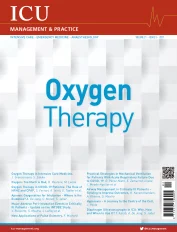
ICU Management & Practice, Volume 21 - Issue 3, 2021
Download PDF |
 |
| PRINT OPTIMISED |
Download PDF |
 |
| SCREEN OPTIMISED |
Editorial
Oxygen Therapy
Supplemental oxygen is an essential component of intensive care and is a commonly used therapy worldwide. The primary goal of oxygen therapy is to prevent hypoxaemia. Since oxygen is usually widely available (except in special circumstances such as during the COVID-19 pandemic) and is relatively inexpensive, it is frequently used in patients with declining oxygen saturation. However, while oxygen therap...
Point of View
Vasopressor Management in Septic Shock: General Overview and Personalised Approaches
This article summarises the proceedings of an ESICM webinar in which two experts discuss vasopressor therapy and its fundamental role in the treatment of septic shock-induced hypotension. They provide an overview of severe septic shock, the benefits of second-line vasopressors and their use in COVID-19 patients. (Jacob C. Jentzer) Vasopressors are classified as drugs that are designed to increase arter...
Cover Story
Oxygen Therapy in Intensive Care Medicine
An overview of current recommendations for oxygen administration in different patient populations and a discussion on optimal oxygen target values. Oxygen is the most commonly used substance in hospitals today. After its discovery around 1771 by the German-Swedish pharmacist Carl Wilhelm Scheele and the English chemist Joseph Priestley, oxygen underwent rapid adoption as a drug in medicine and was already...
Oxygen: Too Much is Bad
Supplemental oxygen administration is a routine treatment administered to a wide majority of critically ill patients. Nevertheless, evidence suggest that exposure to hyperoxia is associated with impaired outcomes. We discuss here the benefits and harms of supplemental oxygen administration in the intensive care unit. In the intensive care unit (ICU), supplemental oxygen administration is a routine treatmen...
Oxygen Therapy in COVID-19 Patients: The Role of HFNC and CPAP
Oxygen therapy and mechanical ventilation in patients with COVID-19 and steps to choose the right therapeutic strategy for each patient. Severe acute respiratory syndrome coronavirus CoV-2 is the highly contagious viral agent responsible for the ongoing COVID-19 pandemic. COVID-19 is the name of the syndrome caused by SARS-CoV-2 infection. Common signs of infection include upper respiratory tract symptoms...
Apnoeic Oxygenation for Intubation - Where is the Evidence?
Apnoeic oxygenation can be used in critically ill patients, without replacing preoxygenation. Hypoxaemia is one of the most common complications during tracheal intubation of critically ill patients (Jaber et al. 2006; Russotto et al. 2021) with an incidence of severe hypoxaemia reaching up to 50% (De Jong et al. 2013; Jaber et al. 2006). Severe hypoxaemia can lead to cardiac arrest, neurologic damage, or m...
Major Adverse Peri-intubation Events in Critically Ill Patients – Update on the INTUBE Study
A third anniversary update on the findings of the INTUBE study, a large international prospective observational study aiming at collecting data on peri-intubation adverse events in critically ill patients. Tracheal intubation in critically ill patients is among the most commonly performed and high-risk procedures (Russotto et al. 2019). Until now, information on peri-intubation adverse events was limited...
New Applications of Pulse Oximetry
The clinical applications of pulse oximetry go far beyond the mere monitoring of SpO2. From home to ICUs, pulse oximeters may help to improve quality of care in patients with respiratory and circulatory disorders, in particular those with the coronavirus disease 2019 (COVID-19). Pulse oximetry was developed in the 1970’s to monitor oxygen saturation (SpO2) during anaesthesia. It is today a mainstay of pe...
Practical Strategies in Mechanical Ventilation for Patients With COVID-19 Acute Respiratory Failure
COVID-19 represents a challenge in respiratory therapy. Evidence-guided protective mechanical ventilation is essential to reduce mortality. “Only a set of well-directed strategies can combat a formidable enemy.” The SARS-CoV-2 virus responsible for the COVID-19 pandemic has a wide variety of clinical presentations. Age is the most important risk factor for critical illness and a poor prognosis, typicall...
Airway Management in Critically Ill Patients – Striving to Improve Outcomes
Tracheal intubation in critically ill patients requires planning, preparation and optimisation of patient’s physiology prior to the procedure. Reducing repeated attempts at tracheal intubation, improving peri-intubation oxygenation, and haemodynamic optimisation, are some of the steps that can reduce the antecedent morbidity and mortality. Airway management including tracheal intubation (TI) is a comm...
Hyperoxia – A Journey to the Centre of the Cell
An overview of hyperoxia, effect of reactive oxygen species on biological processes and tissues and effective strategies for oxygen therapy. The reliance of life on oxygen is a modern and terra-centric view. Oxygen only appeared on the scene about 450 million years ago – wiping out many life forms or forcing them to trap oxygen with porphyrin rings – the ancestor of our own haemoglobin. Therefore st...
Matrix
Diaphragm Ultrasonography in ICU: Why, How, and When To Use It?
An overview of the principles and current applications of diaphragm ultrasound and innovative ultrasound-based techniques. In the intensive care unit (ICU), ultrasound imaging has become increasingly popular for the diagnosis and to guide treatment in critically ill patients (Volpicelli et al. 2020). The use of ultrasound to evaluate the respiratory muscle function (especially the diaphragm) is relatively...
Agenda
Agenda
JULY 9-12 ECCMID 2021 Virtual event https://iii.hm/1aai 17-21 International Society on Thrombosis and Haemostasis (ISTH) 2021 Virtual event https://iii.hm/1aaj AUGUST 31 AUG - 3 SEPT 40th ISICEM Brussels, Belgium https://iii.hm/1aal SEPTEMBER 1-5 17th World Congress of Anaesthesiologists Virtual event https://iii.hm/1ae9 5-8 ERS International Congress 2021 - European Respiratory Society Virtual event...






















